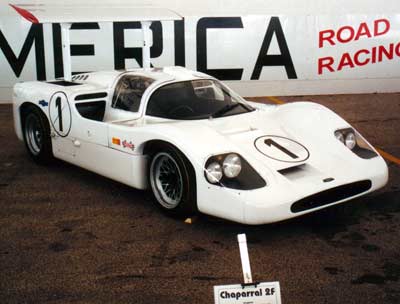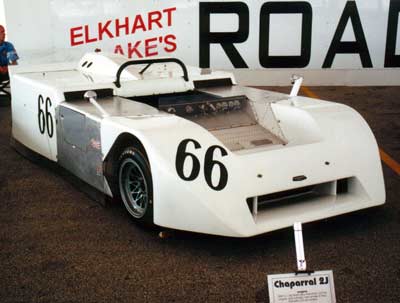INSIDE
RACING
T E C H N O L O G Y
IRT Home
IRT Home
News Page
Contents Page
Newsletter &
Books
email Paul
Hall/Redman Interview, Page 3
The Brian Redman International Challenge at Road America, Jim
Hall Grand Marshal

PH: "Brian, when did you first drive a downforce car?"
BR: "Must have been ..."
JH: "It was a strange thing that happened. Brian's sittin' there trying to remember and it's difficult. That was the winter of 1963/4. We started to run a little lip on the back of our car. Ferrari had done it, actually, a year earlier but the light bulb never went on. When those guys did it Richie [Ginther] was driving. He said, 'Well, it stabalised the car.' "
"Those guys thought they had built a bad car and they put the ducktail on it and that fixed it. There was no jump forward from there. There was no thought that they could take advantage of downforce. That never occurred to them."
BR: "No it didn't. Well Porche's whole philosophy, and we're talking about 1969, was all how fast can we go down the straight and how light can we build a car. That's all they thought about. No thought of downforce."
JH: "Clear till 1969 and that's after we were running wings. Downforce is like supercharging in a way. You take the same machine and you put a little downfoce on it and what happens is the traction goes up by the amount of the downforce. If you keep it balanced you can pick up that much corner speed and it's amazing what it does for you."
PH: "When I got out of school with an ME degree in 1966 I went to work for Pratt & Whitney Aircraft in Florida there were winged sprint cars racing on dirt. I looked at that and thought, that couldn't do anything, but then I thought about it and saw that higher normal force adds to the friction force."
JH: "In '66 we introduced the high wing and I actually heard Eric Broadley [deposed founder of Lola Cars] tell somebody, 'If Hall had the suspension right he wouldn't need that wing.' "

BR: "So three or four years after Jim started using wings these top teams still weren't using them."
JH: Laughs. "Isn't that amazing. If you think about the time span. Eric really thought it was a crutch that we had to use because our car wasn't very good. That's the way he thought about it."
BR: "In 1969 we took the Chevron B16 out at the Nuburgring.
The car was brand new. It wondered all over the road. I know
now that was lack of downforce. We played with it for three days.
We actually went to narrower front wheels thinking it was picking
up the cracks in the road. We tried Bilstein shock absorbers
and it was better. Then on Friday qualifying, we were at an 8
minutes, 30 seconds lap time. The Abarth team had three cars
qualified down in the 8 min, 12 sec. area. On Saturday we added
a 2-inch tab on the rear of the bodywork and straight away we
were 12 seconds faster. We put it on the pole and Abarth were
running for their cars but it was too late. That was 1969 at
Nurburgring."
All of us laugh.
BR: "But even then we didn't really follow up. It was just a tab, not a wing."
PH: "I remember going to races in the 60s at Riverside. I remember seeing the wings on your cars move. You had it rigged so the wing would flatten out on the straights and tip up when you got on the brakes."
JH: "We had some problems with that. We didn't test it enough. I thought we were safe and doing a good job but I really didn't have a good enough handle on it. We lost a lot of races because we didn't finish. We'd have something go wrong. We'd been a lot better off to run last year's car. Hap always said, 'Let me have the old one.' He thought he'd win more races in obsolete racecars because they would finish. And he's right."
PH: "In 1965 you wrote a couple of articles for Car & Driver magazine. I had lost those but a subscriber of my newsletter sent me copies a couple of months ago."
JH: "That's a fairly comprehensive, limited vehicle dynamics article. It's easy to understand and not too complicated but I think it's still technically correct."

PH: What kind of help did you get from General Motors?"
JH: "A lot from the standpoint of my education. There was
a lot of interest on their part when they wanted to make the
decisions on the Corvette. It's funny, they had all that stuff
I wrote in that article written down too. A guy named Maurice
Olley figured out most of the vehicle dynamics stuff in the 30s."
JH: "Another GM guy, Frank Winchell, invited me to go to Cornell labs and fly the B-24, the variable stability airplane. You could go through under and oversteer. You could program it in the air. I was 30 years old and it was a wonderful experience. That's what made me really. Probably Frank Winchell had more to do with my success than anything else. You ask what I got out of it, that's what I got out of it. They made some parts and pieces too. They could make things we couldn't. He'd say let me make one of those, I know how to do that."

PH: "But you guys did a lot of fab work in MIdland. I talked to Troy Rogers (Jim's crew chief from the early years) yesterday about that."
JH: "Yeah, almost all of it. If people come and tell you that the Chaparrals were designed and built at Chevrolet, then that's bull. Sandy {Jim's wife] and I, we mostly shaped all the bodies. The guys would work during the day and when they'd quit we'd come back in and we'd take a spatula and take some clay off and pad it in like we thought it should be and we'd be there till midnight. I'd leave a note and the guys'd be in the next morning at eight and smooth it up.
"It might sound silly but the Chaparral shape is pretty simple. We took all the pieces, the engine, the transaxle, the driver, the wheels, and we just put them in the minimum space you could put get 'em in. Then we started building body around that. We did a lot of mockups because I'm not a good draftsman. That's a part of engineering school I missed. I started school thinking I would be a geologist. When I switched to mechanical engineering and they didn't make me make up the drawing part of it."
PH: "When did you go to Cal Tech?"
JH: "1953 through 1957."
Brian gets a call on his cel phone and excuses himself.
PH: How do you think the engineering education helped you?"
JH: "I don't see how you live without it. That's the way I feel about life. How would you know what you were going to do about almost anything? I've got a terrible curiosity about how things work. It started out when I was a child. I'd tear shit apart and not be able to put it back together. Now I can finally put most of it back together. I'm really curious and that probably hampers me to some extent. I want to know how it works and then I want to make it work better. And that's the whole fun in life really, I've really enjoyed that. It's been great."
PH: "Well, I've run out of questions. I really appreciate the time and the conversation. I really enjoyed it."
JH: "You're welcome."
When our interview ended Jim got up from his chair and turned to move through the small group of people who had been listening to us. A couple of them thanked him for coming to Road America. A few asked for autographs. Jim Hall, ever the gentleman, smiled and obliged one and all.
The links back to the interview pages are at the top.